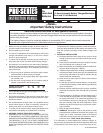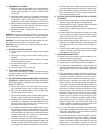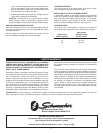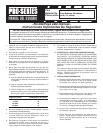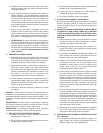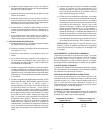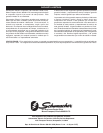2
12. PREPARING TO CHARGE
a) Make sure area around the battery is well ventilated while
battery is being charged. Gas can be blown away by
using a piece of cardboard or other non-metallic mate-
rial as a fan.
b) Add distilled water in each cell until battery acid reaches
levels specified by the battery manufacturer. This helps
purge gas from cells. Do not overfill. For a battery with-
out cell caps, carefully follow manufacturer’s instructions.
c) Study all battery manufacturer’s specific precautions such
as removing or not removing cell caps while charging
and recommended rates of charge.
d) Determine voltage of battery by referring to vehicle
owner’s manual.
DANGER: Never alter the AC plug provided. If it will not fit the
outlet, have a proper outlet installed by a qualified electrician.
Improper connection can result in the risk of electrical shock.
WARNING: Connect and disconnect the battery clips only when
the wall plug is disconnected or arcing may result.
CAUTION: Do not expose to rain. Replace damaged cords or
wires immediately.
13. BATTERY CHARGER LOCATION
a) Locate charger as far away from battery as DC cables
permit.
b) Never place charger directly above battery being
charged.
c) Never allow battery acid to drip on clamps or charger
when reading specific gravity.
d) Do not operate charger in a closed-in area or restrict
ventilation in any way.
e) Do not set battery on top of charger.
14. DC CONNECTION PRECAUTIONS
Connect and disconnect DC clamps only after removing
charger AC power cord from the wall outlet. Do not permit
clamps to touch each other.
15. FOLLOW THESE STEPS WHEN BATTERY IS INSTALLED
IN VEHICLE. A SPARK NEAR BATTERY MAY CAUSE BAT-
TERY EXPLOSION. TO REDUCE THE RISK OF A SPARK
NEAR THE BATTERY:
a) Position AC power cord and DC output cord to reduce
risk of damage by hood, door, or moving engine parts.
b) Stay clear of fan blades, belts, pulleys and other parts
that can cause injury to persons.
c) Check polarity of battery posts. Positive battery post usu-
ally has a larger diameter than the Negative post.
d) Determine which post of battery is grounded (connected)
to the chassis. If Negative post is grounded to the chas-
sis (as in most cases), see Item 15e. If Positive post is
grounded to the chassis, see Item 15f.
e) For negative grounded vehicle, connect Positive clamp
from charger to Positive ungrounded post. Connect
Negative (Black) clamp to vehicle chassis or engine block
away from battery. Do not connect to carburetor, fuel lines
or sheet metal body parts. Connect to a heavy-gauge
metal part of the frame or engine block.
f) For positive-grounded vehicle, connect Negative (Black)
clamp from charger to ungrounded Negative (Black) post
of battery. Connect Positive (Red) clamp to vehicle chas-
sis or engine block away from battery. Do not connect to
carburetor, fuel lines, or sheet metal body parts. Connect
to a heavy-gauge metal part of the frame or engine block.
g) When disconnecting charger, disconnect at wall recep-
tacle, remove clamp from vehicle chassis and then re-
move clamp from battery post.
16. FOLLOW THESE STEPS WHEN BATTERY IS OUTSIDE
OF VEHICLE.
a) Check polarity of battery posts. Positive battery post usu-
ally has a larger diameter than the Negative post.
b) Attach at least a 24" long, 18-gauge or heavier insulated
jumper cable to the Negative battery post.
c) Connect Positive (Red) charger clamp to Positive post
of the battery.
d) Position yourself and free end of the cable as far away
from the battery as possible, then connect the Negative
clamp to the free end of the cable. Do not face battery
when making this final connection.
e) When disconnecting charger, always do so in reverse
sequence of connecting procedure and disconnect the
first connection while as far away from the battery as
possible.
f) A marine (boat) battery must be removed and charged
on shore. To charge it on board requires equipment spe-
cially designed for marine use.
17. OPERATION INSTRUCTIONS
a) Set the 6 and 12 Volt selector switch to match the volt-
age of the battery being charged.
b) Connect charger to a battery as outlined in Section 15 or 16.
c) Plug AC power cord into 120 Volt, 60 Hz receptacle.
d) The amber light indicates battery is being charged, the
green light indicates battery is fully charged, and the red
light indicates trouble. See more detailed explanation
below.
e) When the charger is plugged into an AC outlet but not
connected to a battery, the Green LED will be illuminated.
For proper operation, the battery charger must be
plugged into an AC outlet and connected to a battery.
f) When properly connected, the amber LED indicator
should illuminate. This indicator will stay illuminated un-
til the battery voltage has reached approximately 14.4
Volt and the charge current has decreased to 0.5 Amps.
At this point, the amber indicator turns off and the green
indicator turns on. Also at this point, the internal voltage
reference of the charger will change in order to maintain
the battery voltage at 13.2 Volt. At this lower voltage,
charger current is typically a few milliamperes (mA)
(1 mA = 0.001 A). Under this condition, called maintain,
most batteries can be left charging indefinitely. If the
battery is loaded with 0.5 Amps or greater while in the
maintain condition, the charger will change back to the
normal charging condition described above.
g) Never leave the battery connected to the charger while
the charger is unplugged from the AC outlet. The charger
draws a few milliamperes (mA) from the battery and will
eventually rundown the battery.
h) The Red LED indicates an overload condition. Common
causes are shorting of the battery clamps, reverse-po-
larity connection to a battery, and charging a problem
battery. An overload condition could also be caused by
charging two or more batteries in parallel or charging a
battery larger than the size commonly used in a car or



